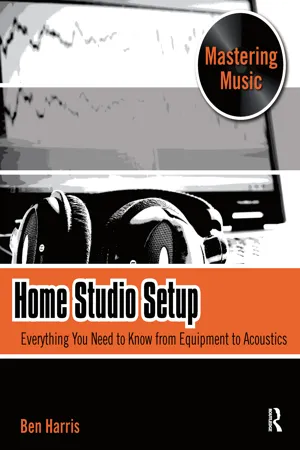
eBook - ePub
Home Studio Setup
Ben Harris
This is a test
Compartir libro
- 200 páginas
- English
- ePUB (apto para móviles)
- Disponible en iOS y Android
eBook - ePub
Home Studio Setup
Ben Harris
Detalles del libro
Vista previa del libro
Índice
Citas
Información del libro
Whether you have a ton of equipment or just the basic gear this book offers an all you need to know to setting up, running and getting great sound from a project studio. In three parts Harris walks you thought Acoustics, Equipment and Recording Technique. From the basics of acoustic treatment to techniques to solve problems specific to your room, and from offering explanations and information of equipment to how to record and create a great mix. In no time you'll be recording, producing great music in your very own studio.
Preguntas frecuentes
¿Cómo cancelo mi suscripción?
¿Cómo descargo los libros?
Por el momento, todos nuestros libros ePub adaptables a dispositivos móviles se pueden descargar a través de la aplicación. La mayor parte de nuestros PDF también se puede descargar y ya estamos trabajando para que el resto también sea descargable. Obtén más información aquí.
¿En qué se diferencian los planes de precios?
Ambos planes te permiten acceder por completo a la biblioteca y a todas las funciones de Perlego. Las únicas diferencias son el precio y el período de suscripción: con el plan anual ahorrarás en torno a un 30 % en comparación con 12 meses de un plan mensual.
¿Qué es Perlego?
Somos un servicio de suscripción de libros de texto en línea que te permite acceder a toda una biblioteca en línea por menos de lo que cuesta un libro al mes. Con más de un millón de libros sobre más de 1000 categorías, ¡tenemos todo lo que necesitas! Obtén más información aquí.
¿Perlego ofrece la función de texto a voz?
Busca el símbolo de lectura en voz alta en tu próximo libro para ver si puedes escucharlo. La herramienta de lectura en voz alta lee el texto en voz alta por ti, resaltando el texto a medida que se lee. Puedes pausarla, acelerarla y ralentizarla. Obtén más información aquí.
¿Es Home Studio Setup un PDF/ePUB en línea?
Sí, puedes acceder a Home Studio Setup de Ben Harris en formato PDF o ePUB, así como a otros libros populares de Tecnología e ingeniería y Ingeniería acústica. Tenemos más de un millón de libros disponibles en nuestro catálogo para que explores.
Información
Section 1 Acoustics
Chapter 1 Introduction to Acoustics
DOI: 10.4324/9780080928456-2
Acoustics can seem like such a basic thing that you don't need to worry about it, or it can be so confusing that the thought of dealing with it keeps you up at night. The next few chapters cover acoustics issues related to the home recording studio on a broad introductory level. The goal is to give you a solid, basic understanding of how sound functions, what common problems occur, and how to remedy those problems. If you want to learn more detailed information about acoustics, there are many wonderful complete books on the topic. These chapters take you to the level of knowledge of most professional recording engineers (users, not designers of studios). All this information will prove useful in understanding microphone placement, more critically listening to speakers, and acoustically treating any space.
Acoustics are very important in the recording studio for two main reasons. First, to record an acoustic instrument properly with a microphone, the mic needs to react well, acoustically, in its space. Second, there must be proper acoustics during the speaker playback so that the listener can hear what is really happening in the mix, to confidently make changes to the audio. These two factors can easily be compared to factors in other artistic fields. For example, improper lighting at a photo shoot could prove disastrous to the final product, no matter how much processing is done. Colors for a bright and exuberant candy commercial might come out looking dull and boring if processed on a black-and-white video monitor. These are just a few of the reasons that acoustics are so important in any recording studio. The key to effective acoustic treatment is first to understand how sound waves interact in an environment—in this case, your room.
Fundamentals of Acoustics
How Sound Travels Through Air
They are called sound waves for a reason. They act very similar to waves in a pool of water. Instead of moving water back and forth, sound waves move air. Think about it this way: If you are at one end of a pool with your hand in the water and your friend drops a rock in the other end of the pool, when the wave eventually gets to your hand, is the water touching your hand the same water molecules that the rock touched when it entered the water? No; the water was simply a road or path for the energy (created by the rock dropping into the water) to travel on. Sound traveling in air is very similar. Any vibration (or noise) will create a wave of sound, which transfers that energy over a highway of air particles. Once the energy makes it to the air particles in our ears, we hear the sound, just as we felt the water against our hand in the pool.
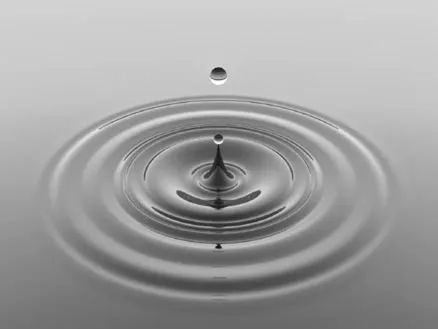
These sound waves traveling in the air are called compression waves. If you could see them, they would look very similar to waves in water except on a three-dimensional plane. That means that sound waves are traveling outward from a source in all directions—left, right, front, back, above, below, everywhere. When you think of sound waves, you might visualize them as two-dimensional waveforms, as they are usually drawn in recording programs and books. They look like this after they are captured by a microphone or pickup, but while traveling in the air in nature, they are three-dimensional compression waves.

Frequency and Amplitude
There are two main measurable elements of a sound wave: frequency and amplitude. Frequency is the rate of forward and backward movement of a compression wave and up and down movement of a waveform. One wavelength is measured from the time that forward or upward movement (the compression) begins, then follows through backward or downward movement (the rarefaction) and returns to the start position. The amount of wavelengths or cycles that occur per second is the definition of frequency, and frequency defines pitch, such as 100 cycles per second, or 100 Hz.
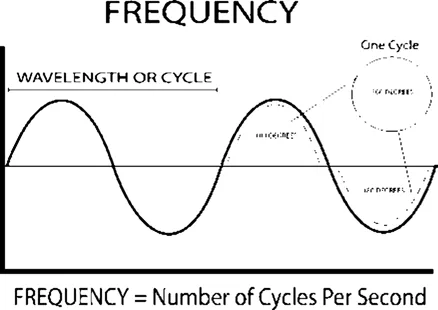
Amplitude is the amount of variation between forward and backward movement, up and down movement, or compressions and rarefactions. Amplitude defines volume and sound pressure levels (SPLs). The higher the pressure, the louder the sound. These levels are defined by a logarithmic measurement called decibels (dB). Decibels are a relative measurement that, when applied to SPL, ranges from 0 dB SPL, the threshold of hearing; 60 dB SPL, the average level of speech; to 120 dB SPL, the threshold of pain. This measurement of dB SPL is different from dBs on faders of a console, but they both have an effect on volume and loudness.
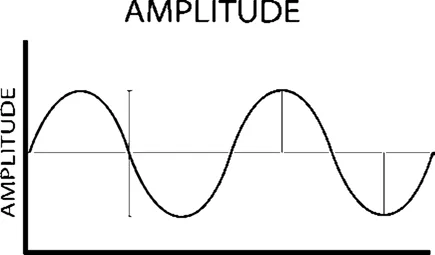
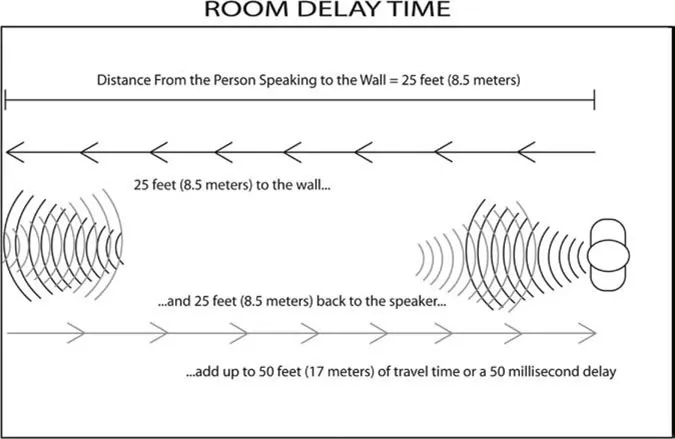
Delay and Reverberation
We mentioned earlier that sound waves travel in every direction, but what happens when they run into something hard? They don't stop; they bounce in another direction, and another, and another. It takes time for the waves to bounce here and there, so every time another bounce occurs, the sound gets more and more delayed. Sound travels at 344 meters, or roughly 1100 feet, per second. This means that if a sound travels 25 feet to a wall and then 25 feet back, by the time it gets back, it will be 50/1000ths of a second, or 50 milliseconds, delayed from the original. If the wave travels much farther than 50 feet, it will be delayed long enough to sound like an audible repeat. This is what happens in the mountains when you yell “Hello” and it sounds like someone is yelling back at you (an echo).
Reverberation (or reverb) is different from delay; reverb is the combination of thousands of different delays repeating at different times, coming at different levels, and coming from different directions. Reverb is the culmination of a sound bouncing off all the different surfaces of a room. Waves will keep bouncing around in a room until the energy has run out. So, the way to control acoustics is to either divert the energy with reflections or diffusion or stop the energy with trapping and absorption.

Common Acoustic Problems
Why should you divert or stop acoustic energy if you don't even know what is causing the problem? There are a few main problems that occur in small rooms including flutter, comb filtering, and room modes.
Flutter and Comb Filtering
Flutter occurs when there are parallel hard surfaces and a sound wave simply gets stuck bouncing back and forth between the two. This sounds like a quick repeated delay and usually occurs in upper-mid and high frequencies.
Comb filtering occurs when two identical sound waves reach a microphone or ear at different times. If the delay between the two is very short, the two waves pile on top of each other and end up boosting some frequencies while canceling out others. This produces a hollow sound, which has a waveform that looks like a comb (see Figures 1.7 and 1.8).
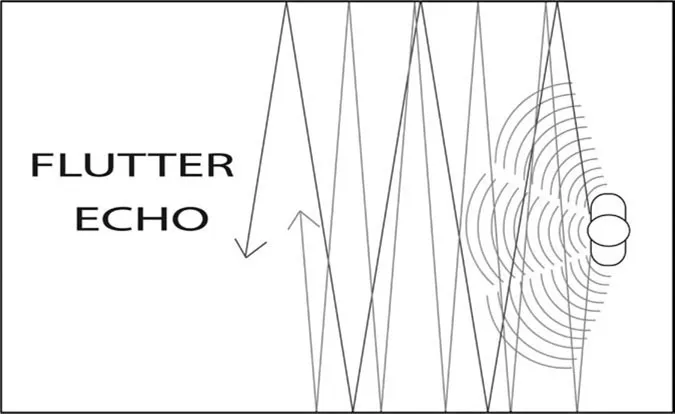
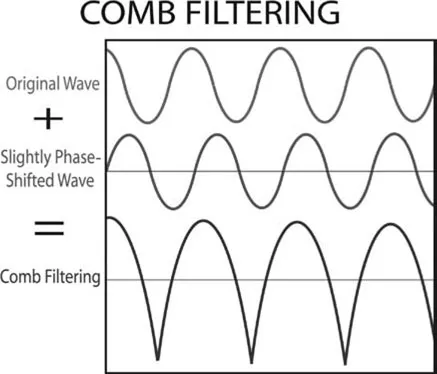
Room Modes
Room modes (or standing waves) are frequencies that are boosted, diminished, or canceled based on the dimensions of a room. If the wavelength of a wave is the same length as the room, the wave will bounce back and pile on top of itself. In this circumstance it will cancel itself out. If the room is one-and-a-half times the length of the wavelength, the wave will double in amplitude or volume. This produces spots in the room where a frequency is boosted (nodes) or canceled out (antinodes), making the sound uneven and problematic.
Flutter and comb filtering are easy to fix, as we'll find out later, but room modes are definitely the most problematic and difficult to fix of the acoustic problems we've mentioned. Room modes are based on the dimensions of the room. For example, a room that is 10 feet by 10 feet will have a problem with 110 Hz because 10 feet is the wavelength of a 110 Hz wave. (If sound travels 1100 feet per second, it will travel 10 feet 110 times in a second.) This also means that there will be problems with 220 Hz and 55 Hz (twice and one half the wavelength). These frequencies are low-mid to low, which carry the muddiness in many instruments. Now your room is making your tracks more muddy because of the room modes.
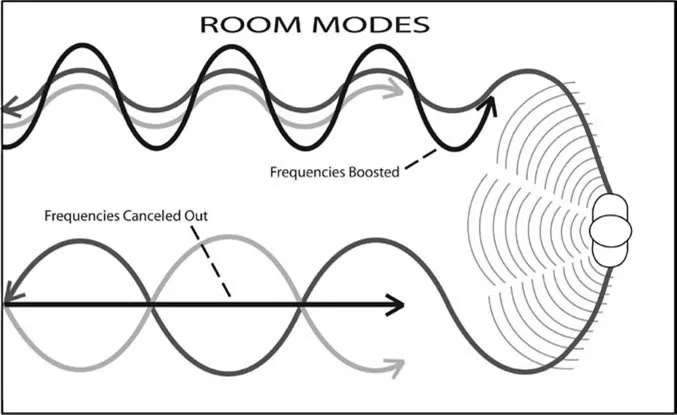
Let's take another example, but this time we'll use a larger room. A room that is 30 feet by 30 feet will have a mode around 30 Hz. This is a very low frequency, almost beyond our audible range (20–20,000 Hz). If anything, this room will make your kick drum sound deep and awesome. To add to the problem, in small home studio rooms producing room modes in the muddy low-midrange frequencies (100–300 Hz), just putting foam on the wall does not solve the problem. Acoustic treatment solutions for room modes require mass and space to perform effectively against these frequencies. We will discuss some solutions to this daunting problem in a few chapters.
...